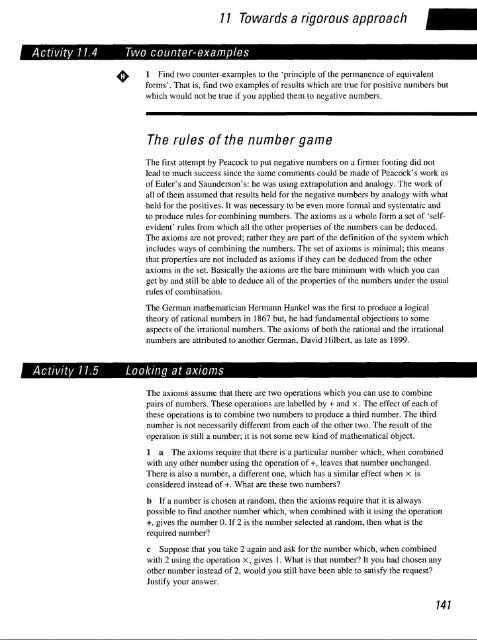history of mathematics - National STEM Centre
history of mathematics - National STEM Centre
history of mathematics - National STEM Centre
You also want an ePaper? Increase the reach of your titles
YUMPU automatically turns print PDFs into web optimized ePapers that Google loves.
Activity 11.4 Two counter-examples<br />
Activity 11.5 Looking at axioms<br />
/ / Towards a rigorous approach<br />
1 Find two counter-examples to the 'principle <strong>of</strong> the permanence <strong>of</strong> equivalent<br />
forms'. That is, find two examples <strong>of</strong> results which are true for positive numbers but<br />
which would not be true if you applied them to negative numbers.<br />
The rules <strong>of</strong> the number game<br />
The first attempt by Peacock to put negative numbers on a firmer footing did not<br />
lead to much success since the same comments could be made <strong>of</strong> Peacock's work as<br />
<strong>of</strong> Euler's and Saunderson's: he was using extrapolation and analogy. The work <strong>of</strong><br />
all <strong>of</strong> them assumed that results held for the negative numbers by analogy with what<br />
held for the positives. It was necessary to be even more formal and systematic and<br />
to produce rules for combining numbers. The axioms as a whole form a set <strong>of</strong> 'self-<br />
evident' rules from which all the other properties <strong>of</strong> the numbers can be deduced.<br />
The axioms are not proved; rather they are part <strong>of</strong> the definition <strong>of</strong> the system which<br />
includes ways <strong>of</strong> combining the numbers. The set <strong>of</strong> axioms is minimal; this means<br />
that properties are not included as axioms if they can be deduced from the other<br />
axioms in the set. Basically the axioms are the bare minimum with which you can<br />
get by and still be able to deduce all <strong>of</strong> the properties <strong>of</strong> the numbers under the usual<br />
rules <strong>of</strong> combination.<br />
The German mathematician Hermann Hankel was the first to produce a logical<br />
theory <strong>of</strong> rational numbers in 1867 but, he had fundamental objections to some<br />
aspects <strong>of</strong> the irrational numbers. The axioms <strong>of</strong> both the rational and the irrational<br />
numbers are attributed to another German, David Hilbert, as late as 1899.<br />
The axioms assume that there are two operations which you can use to combine<br />
pairs <strong>of</strong> numbers. These operations are labelled by + and x. The effect <strong>of</strong> each <strong>of</strong><br />
these operations is to combine two numbers to produce a third number. The third<br />
number is not necessarily different from each <strong>of</strong> the other two. The result <strong>of</strong> the<br />
operation is still a number; it is not some new kind <strong>of</strong> mathematical object.<br />
1 a The axioms require that there is a particular number which, when combined<br />
with any other number using the operation <strong>of</strong> +, leaves that number unchanged.<br />
There is also a number, a different one, which has a similar effect when x is<br />
considered instead <strong>of</strong> +. What are these two numbers?<br />
b If a number is chosen at random, then the axioms require that it is always<br />
possible to find another number which, when combined with it using the operation<br />
+, gives the number 0. If 2 is the number selected at random, then what is the<br />
required number?<br />
c Suppose that you take 2 again and ask for the number which, when combined<br />
with 2 using the operation x, gives 1. What is that number? It you had chosen any<br />
other number instead <strong>of</strong> 2, would you still have been able to satisfy the request?<br />
Justify your answer.<br />
141
















